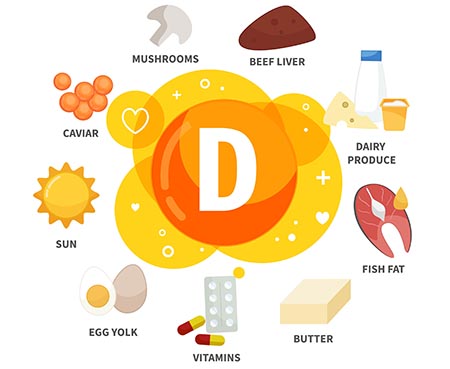
Charleston, SC — Medical University of South Carolina (MUSC) College of Medicine scientists and clinicians, led by world-renowned vitamin D research experts Bruce Hollis, Ph.D., professor emeritus in the Department of Pediatrics, and Carol Wagner, M.D., a professor in the Department of Pediatrics and neonatologist, are planning a focused research effort to determine if individuals with sufficient baseline levels of vitamin D have more protection against severe COVID-19 infection.
“Our team has the ability to determine vitamin D levels for COVID-19-positive patients and track that information to begin this work. This area of study is worthy of their expertise and efforts,” said David J. Cole, M.D., FACS, MUSC president. “This is a great opportunity to raise awareness that this due diligence is needed so we can potentially help particularly vulnerable populations in our community.”
To be clear, neither these studies nor MUSC are suggesting that vitamin D cures or prevents COVID-19 infection. However, the body of prior and emerging scientific evidence would suggest that individuals with low vitamin D levels who contract COVID-19, including African Americans and elderly nursing home residents, might experience worse clinical outcomes than other groups with normal vitamin D levels.
“It is important to study this topic to determine if recommending vitamin D supplementation for vulnerable populations can make a difference in COVID-19 outcomes. If valid,” Cole explained, “we would have an inexpensive, readily available strategy not only to help these groups of individuals but also the general population of South Carolina and beyond.”
MUSC scientists point out that recent COVID-19 and vitamin D studies suggest that at-risk individuals with historically low levels of vitamin D also had increased severity of COVID-19 infection and worse clinical outcomes, especially if the viral infection reached the lower respiratory tract. Certain cells located there are known primary targets of the virus, and if affected, it becomes harder for the lungs to initiate tissue repair and rebound from an infection, thus causing acute respiratory distress and the hospitalization of patients nationwide.
Hollis, Wagner and their team are rapidly pursuing clinical studies to validate or refute the clinical assumption that when patients have sufficient vitamin D levels, their immune responses to the virus’ primary targets are enabled, stronger and more capable of fighting off the most acute form of COVID-19.
“If we know that certain groups of the population are already at high risk for deficiency, and recent, valid studies suggest that increasing vitamin D levels might help prevent or lessen the severity of the disease, it would seem irresponsible to us as health care providers and scientists not to pursue this for our statewide and national community,” Wagner said. “We know vitamin D has a critical role in many functions of our overall health, so we have a responsibility to our families, neighbors, coworkers, friends and community to help answer this question.”
Essentially, the team seeks to replicate recent findings related to COVID-19 and vitamin D deficiency and explore the idea that patients might need to reach sufficient vitamin D levels through the appropriate clinical standard dosing of IV or oral supplements or, in some cases, simply get more exposure to sunlight. As the research effort matures, Hollis and Wagner plan to offer guidance on whether supplementation in certain individuals improves their clinical outcomes following a positive COVID-19 test. In addition, they hope to offer insight into whether vitamin D supplementation for all South Carolinians could improve their vitamin D statuses and mitigate the severity of COVID19 should they become infected.
“Our previous work has demonstrated that African Americans and other vulnerable populations can achieve vitamin D sufficiency through clinically validated supplements, which is a relatively inexpensive therapy that has a large safety profile when given in doses between 4,000 to 6,000 international units a day to adults,” Hollis said. “Some individuals with low levels of melanin in their skin can achieve better vitamin D sufficiency just by standing or sitting for 15 to 20 minutes in the direct sunlight each day that its possible, which is another easy way to address low vitamin D levels.”
Scientists know that vitamin D is present in very few foods, and typically at lower levels than what is needed for sufficiency, but it can be produced by the body when human skin is exposed to ultraviolet rays from sunlight, which triggers vitamin D synthesis. It promotes calcium absorption by the gut and helps strengthen bones. Additionally, vitamin D has been shown to play an important role in a number of other bodily processes like modulation of cell growth and differentiation and enabling proper innate and adaptive immune functions to fight off pathogens. It’s also thought to protect against some chronic conditions, including cardiovascular disease, diabetes and some cancers.
Hollis and Wagner have more than 60 years of combined vitamin D research experience, with a collective body of work referenced and replicated across the spectrum by institutions such as Harvard University and the National Institutes of Health. They have accrued thousands of citations and have been published in numerous peer-reviewed journals on various subtopics around vitamin D deficiency and sufficiency.
About the Medical University of South Carolina
Founded in 1824 in Charleston, MUSC is the oldest medical school in the South, as well as the state’s only integrated, academic health sciences center with a unique charge to serve the state through education, research and patient care. Each year, MUSC educates and trains more than 3,000 students and nearly 800 residents in six colleges: Dental Medicine, Graduate Studies, Health Professions, Medicine, Nursing and Pharmacy. The state’s leader in obtaining biomedical research funds, MUSC brought in more than $284 million in fiscal year 2019.
As the clinical health system of the Medical University of South Carolina, MUSC Health is dedicated to delivering the highest quality patient care available, while training generations of competent, compassionate health care providers to serve the people of South Carolina and beyond. Comprising some 1,600 beds, more than 100 outreach sites, the MUSC College of Medicine, the physicians’ practice plan, and nearly 275 telehealth locations, MUSC Health owns and operates eight hospitals situated in Charleston, Chester, Florence, Lancaster and Marion counties. In 2019, for the fifth consecutive year, U.S. News & World Report named MUSC Health the No. 1 hospital in South Carolina. To learn more about clinical patient services, visit muschealth.org.
MUSC and its affiliates have collective annual budgets of more than $3.2 billion. The more than 17,000 MUSC team members include world-class faculty, physicians, specialty providers and scientists who deliver groundbreaking education, research, technology and patient care. For information on academic programs, visit musc.edu.
PRESS CONTACT:
Heather Woolwine
843-792-7669
woolwinh@musc.edu








